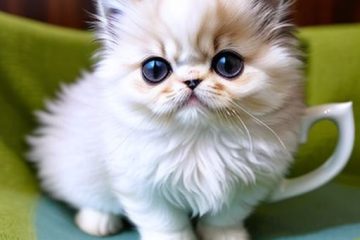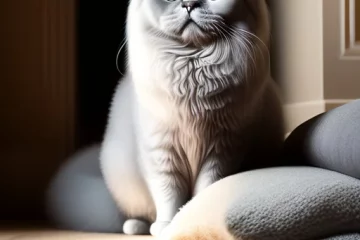The Persian Siamese mix, also known as Himalayan Siamese cat (or Colourpoint Persian in Europe), is a breed of cats that, as the name implies, is a combination of Siamese and Persian through selective breeding.
Its striking blue eyes and rich, sumptuous coats can entice and capture the eye of anyone.
Personality
With her friendly, laid-back temperament, he has become one of the world’s most famous breeds.
Discard all that you learned about them in the movie Lady and the Tramp.
An animated film, although it’s funny, should not be looked at as a source of information.
These cats’ arrogant nature shown in that movie is just bogus because these are some of the most lovable breeds that can adapt to any situation.
Himalayan cats are very social in disposition and tend to be dependent on humans for protection and camaraderie.
They are quite the attention seekers who love to be petted and pampered.
They can be moody at times, but who don’t need space from time to time? If you want a cat who you can cuddle all day, Himalayan Siamese is a perfect option for you.
Unlike most cats, they are not overly-energetic and would love to curl up in your lap all day.
Due to their dependent nature, it is advised to adopt two cats instead of one if you’re usually out due to work so that they can keep each other’s company.

Physical Traits
Like their Persian counterparts, they are of average size with a compact torso, strong muscle, and smoothness giving rise to their athletic physique.
Their faces are flat, their heads smooth and round, their eyes are stunning, glassy blue, the eye color is inherited from their Siamese ancestors.
They have short, stubby legs, which make it harder for them to leap higher like other cats.
Another characteristic Persian ancestors bestowed upon them is their eye-catching velvety fur that makes you want to bury your face in it. The coat mostly comes in these colors:
- Lilac
- Tortoiseshell
- Seal
- Blue
- Chocolate
- Red
These colors represent the points or the top of their furs; however, the bulk of the fur is usually white or cream.
There are two types of Himalayan Persians according to the face structure:
- Traditional ones are the Himalayans with doll face.
- Peke-faced or Ultra-type, which has mashed face features.
Historical Origin
Some people in Switzerland experimented in the 1930s to cross between the Persian cats and the Siamese cats, perhaps to create a blend having the best qualities of both: the rich fur and stunning eyes of the Siamese and the brilliant physique of a Persian.
They succeeded in doing so when the first Himalayan Persian mix breed came into existence.
Some sources claim that these cats were indigenous to Siam, which is known today as Thailand, for thousands of years, bred first, especially for Thai royalty.
Due to some conservative viewpoints of feline organizations that weren’t willing to accept the Himalayan Persian mix as a true breed, he wasn’t officially recognized, until 1957, in England, known then widely by the name “Long-haired Colourpoint.”
And although he was first introduced to the U.S. in 1878 by a diplomat posted in Bangkok, it was recognized by the US much later (in the twentieth century). There, it became quite popular afterward.
Why is it called Himalayan?
The name “Himalayan” came to be due to these cats’ close resemblance to the Himalayan rabbit.
As many people mistakenly think, it is not named due to the roots of the cat going back to the Oriental region.
Before you type “Himalayan Siamese cat price” in the Google search engine, read on first to know the ins and outs of how to take care of these gorgeous creatures.
Caring for a Siamese Persian Cat
The Siamese Persian cat mix breed is kind of low-maintenance; it doesn’t require extra care in the clean-up because they are indoor cats.
But it’s still recommended to groom them daily or every two days to prevent debris buildup.
Although you can do with monthly brushing, doing it every day will keep their coats extra sleek and shiny, and you won’t have to deal with a pile of loose hairs at the end of the month.
Bathing them, on the other hand, should be sufficient once a month.
Experts recommend that you brush your cat’s teeth once or twice a week to keep them from building plaque.
Although they are not hyperenergetic as other cats, they tend to be quite active.
So if you’re looking to buy them, be sure to keep an eye out for the latest interactive toys that you could buy as well, to keep them busy when you’re not around.
Having trees in your house also helps because these cats love to climb. Himalayan cats also love to play fetch.
All in all, the toys you pick should be the ones which can stimulate their necessary hunting skills.
This type of motivation in the feline brain would keep them active and healthy. So the next time you search for the Persian Siamese cat price, look for affordable toys online.
In addition to creating a stimulating environment for this Siamese Persian mix cat, you need to provide scratching pads or posts to your cats so they can sharpen their claws there instead of ripping off the curtains.
You May Also Like: Tortoiseshell Persian Cats: A Beautiful and Unique Feline Breed
Health Issues
Himalayans tend to be very healthy if you take good care of them and regularly visit the vet to see if everything’s in check.
This is crucial because although they get sick very rarely, they suffer from hereditary disorders like congenital heart defects.
Conducting genetic tests is also essential because some Himalayans have the gene that causes Polycystic Kidney Disease (PKD) due to their Persian origin.
Several cysts develop in the kidney. If the genetic tests pick up that gene, the cat may be spayed/neutered depending on the gender.
Other health problems they commonly suffer from are:
- Asthma
- Ophthalmic problems
- Urinary tract infections
- Kidney problems
- Mandibular deficiency
- Gastrointestinal problems like hairballs getting stuck inside them when accidentally swallowed
With the right preventive measures, you can prolong the life expectancy of Himalayan cats, the average being 12-15 years.
Conclusion
The Siamese Persian cat is a stunning and affectionate feline companion that brings together the best of both the Persian and Siamese cat breeds.
With their striking appearance, intelligent nature, and loving personality, they make delightful additions to households seeking a loyal and elegant pet.
Thanks for reading. We hope that you find the perfect cat (or cats) for you!
Frequently Asked Questions (FAQs)
1. How did the Siamese Persian cat breed come into existence?
The Siamese Persian cat breed originated in the 1950s when breeders crossed the Persian and Siamese cat breeds to combine their desirable traits.
2. Do Siamese Persian cats require a lot of grooming?
Yes, Siamese Persian cats have long hair and require regular grooming to prevent matting and keep their coat healthy and tangle-free.
3. Are Siamese Persian cats suitable for families with children?
Yes, Siamese Persian cats have a gentle and patient nature, making them well-suited for families with children.
4. Are Siamese Persian cats vocal like Siamese cats?
Yes, Siamese Persian cats inherit the vocal nature of Siamese cats and are known for their expressive communication through meows and chirps.
5. Are Siamese Persian cats prone to any specific health issues?
Siamese Persian cats may be prone to health issues such as polycystic kidney disease (PKD) and respiratory problems. Regular vet check-ups are important to monitor their health.
6. How long do Siamese Persian cats typically live?
With proper care, Siamese Persian cats can live for approximately 12 to 15 years or even longer.
7. Are Siamese Persian cats suitable for apartment living?
Yes, Siamese Persian cats can adapt well to apartment living as long as they receive adequate mental and physical stimulation.
8. Can Siamese Persian cats get along with other pets?
With proper introductions and gradual socialization, Siamese Persian cats can coexist peacefully with other pets, including dogs and other cats.
9. Do Siamese Persian cats require a specific diet?
Siamese Persian cats should be fed a nutritionally balanced diet that meets their specific needs, including maintaining a healthy weight and promoting a shiny coat.
10. Are Siamese Persian cats high-maintenance in terms of care?
Siamese Persian cats do require regular grooming and attention to their coat, but with proper care and attention, they can be relatively low-maintenance pets.


